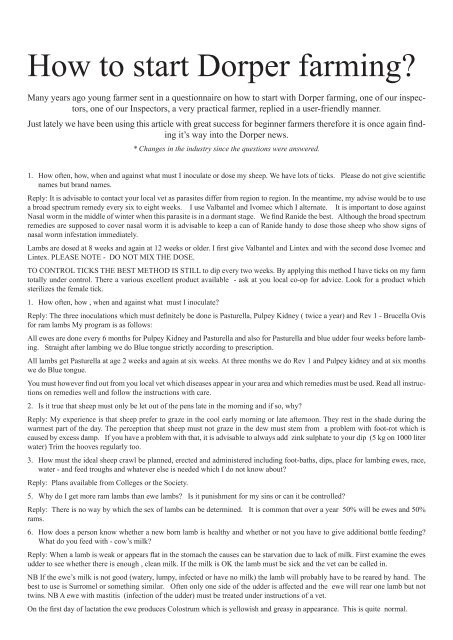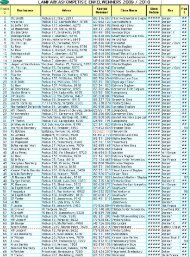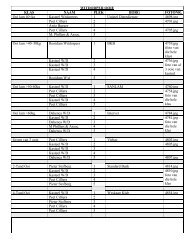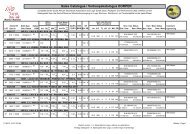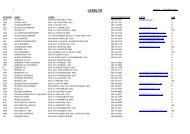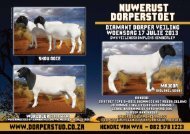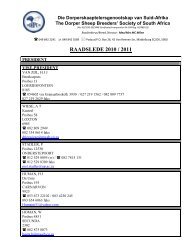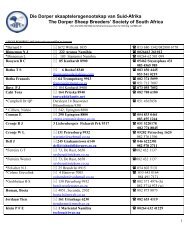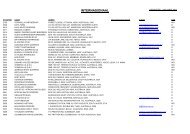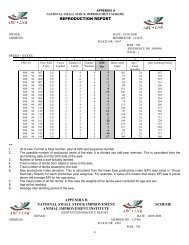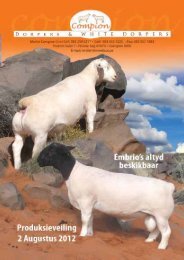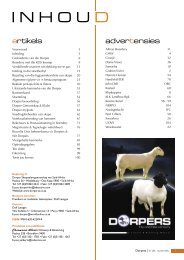Create successful ePaper yourself
Turn your PDF publications into a flip-book with our unique Google optimized e-Paper software.
<strong>How</strong> <strong>to</strong> <strong>start</strong> <strong>Dorper</strong> <strong>farming</strong><br />
Many years ago young farmer sent in a questionnaire on how <strong>to</strong> <strong>start</strong> with <strong>Dorper</strong> <strong>farming</strong>, one of our inspec<strong>to</strong>rs,<br />
one of our Inspec<strong>to</strong>rs, a very practical farmer, replied in a user-friendly manner.<br />
Just lately we have been using this article with great success for beginner farmers therefore it is once again finding<br />
it’s way in<strong>to</strong> the <strong>Dorper</strong> news.<br />
* Changes in the industry since the questions were answered.<br />
1. <strong>How</strong> often, how, when and against what must I inoculate or dose my sheep. We have lots of ticks. Please do not give scientific<br />
names but brand names.<br />
Reply: It is advisable <strong>to</strong> contact your local vet as parasites differ from region <strong>to</strong> region. In the meantime, my advise would be <strong>to</strong> use<br />
a broad spectrum remedy every six <strong>to</strong> eight weeks. I use Valbantel and Ivomec which I alternate. It is important <strong>to</strong> dose against<br />
Nasal worm in the middle of winter when this parasite is in a dormant stage. We find Ranide the best. Although the broad spectrum<br />
remedies are supposed <strong>to</strong> cover nasal worm it is advisable <strong>to</strong> keep a can of Ranide handy <strong>to</strong> dose those sheep who show signs of<br />
nasal worm infestation immediately.<br />
Lambs are dosed at 8 weeks and again at 12 weeks or older. I first give Valbantel and Lintex and with the second dose Ivomec and<br />
Lintex. PLEASE NOTE - DO NOT MIX THE DOSE.<br />
TO CONTROL TICKS THE BEST METHOD IS STILL <strong>to</strong> dip every two weeks. By applying this method I have ticks on my farm<br />
<strong>to</strong>tally under control. There a various excellent product available - ask at you local co-op for advice. Look for a product which<br />
sterilizes the female tick.<br />
1. <strong>How</strong> often, how , when and against what must I inoculate<br />
Reply: The three inoculations which must definitely be done is Pasturella, Pulpey Kidney ( twice a year) and Rev 1 - Brucella Ovis<br />
for ram lambs My program is as follows:<br />
All ewes are done every 6 months for Pulpey Kidney and Pasturella and also for Pasturella and blue udder four weeks before lambing.<br />
Straight after lambing we do Blue <strong>to</strong>ngue strictly according <strong>to</strong> prescription.<br />
All lambs get Pasturella at age 2 weeks and again at six weeks. At three months we do Rev 1 and Pulpey kidney and at six months<br />
we do Blue <strong>to</strong>ngue.<br />
You must however find out from you local vet which diseases appear in your area and which remedies must be used. Read all instructions<br />
on remedies well and follow the instructions with care.<br />
2. Is it true that sheep must only be let out of the pens late in the morning and if so, why<br />
Reply: My experience is that sheep prefer <strong>to</strong> graze in the cool early morning or late afternoon. They rest in the shade during the<br />
warmest part of the day. The perception that sheep must not graze in the dew must stem from a problem with foot-rot which is<br />
caused by excess damp. If you have a problem with that, it is advisable <strong>to</strong> always add zink sulphate <strong>to</strong> your dip (5 kg on 1000 liter<br />
water) Trim the hooves regularly <strong>to</strong>o.<br />
3. <strong>How</strong> must the ideal sheep crawl be planned, erected and administered including foot-baths, dips, place for lambing ewes, race,<br />
water - and feed troughs and whatever else is needed which I do not know about<br />
Reply: Plans available from Colleges or the Society.<br />
5. Why do I get more ram lambs than ewe lambs Is it punishment for my sins or can it be controlled<br />
Reply: There is no way by which the sex of lambs can be determined. It is common that over a year 50% will be ewes and 50%<br />
rams.<br />
6. <strong>How</strong> does a person know whether a new born lamb is healthy and whether or not you have <strong>to</strong> give additional bottle feeding<br />
What do you feed with - cow’s milk<br />
Reply: When a lamb is weak or appears flat in the s<strong>to</strong>mach the causes can be starvation due <strong>to</strong> lack of milk. First examine the ewes<br />
udder <strong>to</strong> see whether there is enough , clean milk. If the milk is OK the lamb must be sick and the vet can be called in.<br />
NB If the ewe’s milk is not good (watery, lumpy, infected or have no milk) the lamb will probably have <strong>to</strong> be reared by hand. The<br />
best <strong>to</strong> use is Surromel or something similar. Often only one side of the udder is affected and the ewe will rear one lamb but not<br />
twins. NB A ewe with mastitis (infection of the udder) must be treated under instructions of a vet.<br />
On the first day of lactation the ewe produces Colostrum which is yellowish and greasy in appearance. This is quite normal.
7 & 8. Must lambs be tailed Castration<br />
Reply: There are various reasons why tails are amputated. One being preventing flies from entering under the tail and laying eggs<br />
which then cause infections.<br />
I dock tails at 2 weeks of age and castrate the lambs that must be done at the same time. I use castrating rings for both purposes. To<br />
castrate, ensure that both testicles are in the scrotum and pull the elastic right over <strong>to</strong> the narrowing of the scrotum. It is important<br />
not <strong>to</strong> dock tails <strong>to</strong>o short . Apply elastic about 15 mm from the body over the tail. Both tail and testicle rings must then be sprayed<br />
well with healing- / wound oil <strong>to</strong> keep flies away and should be repeated until the body-parts fall off and is healed.<br />
9. What must sheep be fed with We have lots of grass and they are fat, but what should I plant as additional feed when I want<br />
<strong>to</strong> keep more sheep per hectare<br />
What about kikuyu or life grass which they advertise so much I have a little bit of bana-grass but I think it is <strong>to</strong>o tall for a<br />
sheep.<br />
Reply: I find dry, baled Lucerne is always a good feed which can be given at any time. The <strong>Dorper</strong> is not a selective grazer and<br />
can utilize most grasses and green feed provided there is enough of it winter and summer. You may find a lick in block form useful<br />
seeing that such grasses lack quite a bit of the essential elements. I find that sheep on green feed also need dry feed. It is therefore a<br />
good practice <strong>to</strong> also put out a bale of dry Lucerne in the day as well as in the crawl at night.<br />
10. Should I leave the ram between the ewes and let nature take it’s course or must I interfere Agricultural publications speak of<br />
the group method, hand method and sponging but this is all Greek <strong>to</strong> me! What does it mean, which method must I use , how<br />
and why<br />
Reply: The ewe’s ovulation cycle is 17 days. Therefore it is a popular practice <strong>to</strong> put the ram in for 6 weeks and take him out for 6<br />
weeks. This has the following advantages:<br />
a. The lambs fall in groups which makes your work easier<br />
b. You can alternate different rams and will know exactly which one’s lambs are arriving<br />
c. Should a ewe for some reason or other not “take” six weeks is not a terribly long period <strong>to</strong> wait before putting the ram in again.<br />
d. Six weeks allows the ewes two ovulations while the rams are with them<br />
12. I have one or two sheep with runny noses. People tell me this is nasal worm. Is there such a thing, what does it look like,<br />
where does it come from and what do I do about it<br />
Reply: This was addressed under Question 1<br />
13. <strong>How</strong> do I know when a sheep is sick, how do I determine which disease it has and how do I cure it<br />
Reply: In most cases the sheep appears uneasy and lethargic or a problem will be clearly visible like a wound, swelling or abscess.<br />
When the sheep shows no visible symp<strong>to</strong>ms but looks ill, the first step is <strong>to</strong> take the temperature which should be 39,5 degrees. High<br />
temperature indicates infection and antibiotics should be administered. It could also be blue <strong>to</strong>ngue or heart water ( if your area is<br />
prone <strong>to</strong> these). In the beginning I often called the vet. This is an expensive way of learning, but a excellent way. Now I am able<br />
<strong>to</strong> diagnose most diseases which my sheep may get, myself and <strong>to</strong> treat it effectively.<br />
Abscesses are highly infectious and I recommend that you ask your vet <strong>to</strong> show you the correct method of lancing and treating<br />
these.<br />
14. I would like <strong>to</strong> keep record of my sheep <strong>to</strong> ensure that I do not keep “passengers” but productive animals. What must I record,<br />
how do I do it and how do I interpret it<br />
Reply: The basic requirement of recording is <strong>to</strong> record each ewe’s lambing rate and <strong>to</strong> identify and eliminate weak producers.<br />
Firstly a ewe must be tagged with her own number ( I <strong>start</strong>ed at no 1) and you have <strong>to</strong> have a card for her. All lambs which arrive<br />
must then be tagged and recorded on the mother’s card. Important information is date of birth, sex, father (a) weaning date and<br />
weaning weight.<br />
( There are record cards available from the Society)<br />
*( Electronic technology can be implemented for this purpose <strong>to</strong>day)<br />
15. I want <strong>to</strong> number the sheep in such a way that I do not have <strong>to</strong> carry a book <strong>to</strong> identify the family. Is there a sensible number<br />
system according <strong>to</strong> which this can be done<br />
Reply: It is impossible <strong>to</strong> place all the information you need in a crawl on a ear tag. I suggest you use the following number system:<br />
(a) Mark your thirty ewes from 1 - 30 (meaning all that will appear on their tags will be a number between 1 and 30)<br />
(b) All new ewes purchase will then be from 31 onward<br />
(c) Number your lambs according <strong>to</strong> the year in which they arrive plus a cereal number for example 92.1, 92.2, 92.3 etc<br />
My tags look like this <strong>to</strong>p: 92.1 RC<br />
Bot<strong>to</strong>m 315 X
92.1 RC = Year-cereal number plus the father’s code<br />
(RC= “Rocky”)<br />
315 X = Family number plus X which indicates one<br />
of a twin<br />
Single lambs get nothing and triplets get XX<br />
The “family number” is the number of the very first ewe which <strong>start</strong>ed that line on my farm. It is carried over <strong>to</strong> each lamb and <strong>to</strong><br />
the female off -spring like a man’s surname is carried by his children.<br />
16. Somebody says I must use Aussie-tags <strong>to</strong> number the sheep. <strong>How</strong> do I work with these<br />
Reply: I use metal tags but engrave my own information on it.<br />
(* there are various tags available <strong>to</strong>day- even micro chips!)<br />
17. What does the tags look like which the Inspec<strong>to</strong>rs of the Society use<br />
Reply: <strong>Dorper</strong>s receive a tag with a D + the stud number on one side and a cereal number on the other side. White <strong>Dorper</strong>s has<br />
the same but only a D with a diamond frame around it.<br />
18. <strong>How</strong> do I know when a ewe is <strong>to</strong>o old <strong>to</strong> breed further<br />
Reply: Sheep’s teeth wear off. Teeth gradually get very short and uneven. As long as there is soft food ( like on lands) available, an<br />
old ewe can carry on, but should be classed out as soon as she or her lamb’s condition is poor in spite of good food. Weaker producing<br />
ewes must naturally be culled as soon as their teeth seem short.<br />
19. <strong>How</strong> do I know when I must get a ram<br />
20. What do I do with old rams when in-breeding becomes a possibility<br />
Reply: A good breeding ram can be used a number of years, always on the same ewes. He should not be put with his own ewe lambs.<br />
And therefore you will have <strong>to</strong> acquire new rams ever so often.<br />
A Weak breeding ram or old ram you send <strong>to</strong> the abat<strong>to</strong>ir. A good breeding ram which you can no longer use in your flock, can be<br />
swapped or sold.<br />
21. What is the best method of controlling ticks People say I must use Deadline.<br />
Reply: I believe people use Deadline although this is not meant for sheep. I still prefer <strong>to</strong> dip as recommended in question 1<br />
22. My crawl has a cement floor which has quite layer of manure on it. When sheep move around it creates dust. Is this healthy<br />
Must I remove the manure and let the sheep sleep on the cement Must a remove the cement and let the sheep sleep on the<br />
ground<br />
Reply: The surface on which sheep sleep is not important as long as the drainage is good. Where possible dust must be reduced or<br />
eliminated.<br />
23. Presently my sheep lamb either in the veld or at night in the crawl. The lamb immediately joins the flock and runs <strong>to</strong> the veld<br />
with his mother from day one. It has happened that a lamb is fast asleep and the mother is running around desperately. Is this<br />
practice correct or must the ewe and lamb be kept separate from the flock If so, how long, must it be in a grassy camp or in a<br />
crawl If in a crawl or pen - what do I feed her<br />
Reply: Generally <strong>Dorper</strong> ewes are excellent mothers en seldom looses their lambs.<br />
Now and then there is a ewe ( normally with the first lamb or twins) who battle <strong>to</strong> keep the lamb with her. Such a ewe can then be<br />
put in a smaller place with her lambs in order <strong>to</strong> get used <strong>to</strong> one another. You can feed dry Lucerne.<br />
24. Some of the ewes I purchased has biggish lambs but I have no idea how old they are. Some lambs are grazing full-out already<br />
but still suckles. Some of them are so big that they lift the ewe’s hind quarter from the ground when suckling. Is this normal<br />
- must they still suckle when they are so big Do they wean themselves or must I remove them from the mothers Do the<br />
suckling have and effect on the ewe that she may not take ram while she has a lamb<br />
Reply: It is normal practice <strong>to</strong> wean a lamb at three or 4 months of age. (Remember <strong>to</strong> dose Lintex and <strong>to</strong> inject Pulpy Kidney and<br />
Rev 1)<br />
25. Must sheep have water in their sleeping crawl<br />
Reply: Sheep should have free access <strong>to</strong> clean dinking water at all times. Troughs in crawls and camps should be checked daily <strong>to</strong><br />
ensure that they are clean.<br />
26. Some of the Ram lambs is trying <strong>to</strong> cover the ewes. Is this a sign that the older ram is not working or are the young ones just<br />
having fun<br />
Reply: Young ewes, rams and castrated rams are inclined <strong>to</strong> jump on one another.
This is just a game but beware! <strong>Dorper</strong> lambs are fertile from 3 -4 months and could get pregnant or cover their own mothers.<br />
27. Here in our area theft is a problem. Is there a way <strong>to</strong> mark a sheep in order <strong>to</strong> identify the carcass , skin or head as your property<br />
Reply: Tat<strong>to</strong>oing is law. Use the green marking ink it works on the black ears.<br />
28. Will the ram know when a ewe lamb is “old enough” or must ewe lambs be kept separately so that they do not get pregnant<br />
<strong>to</strong>o young. What is <strong>to</strong>o young<br />
Reply: It is good practice <strong>to</strong> mate ewes only at 10 months of age. They need <strong>to</strong> be two- <strong>to</strong>othed when their lambs arrive so that they<br />
do not battle <strong>to</strong> eat when having <strong>to</strong> feed a lamb.<br />
*(Remember <strong>to</strong> have all young rams age 10 months and older and your breeding rams tested for Brucella Ovis every year NB.<br />
Never borrow or buy untested rams)<br />
Talk <strong>to</strong> other <strong>Dorper</strong> farmers or sheep farmers and learn from them. If you are serious about breeding it is recommended that you<br />
attend at least a Junior course on <strong>Dorper</strong>s <strong>to</strong> broaden your knowledge.<br />
We trust this will assist many new and inexperienced farmers once again.<br />
Never hesitate <strong>to</strong> ask questions - that is the only way you learn. Contact The Society or any inspec<strong>to</strong>r listed in this book.


